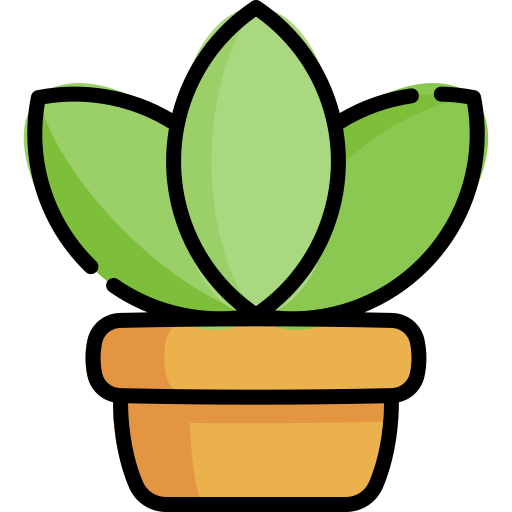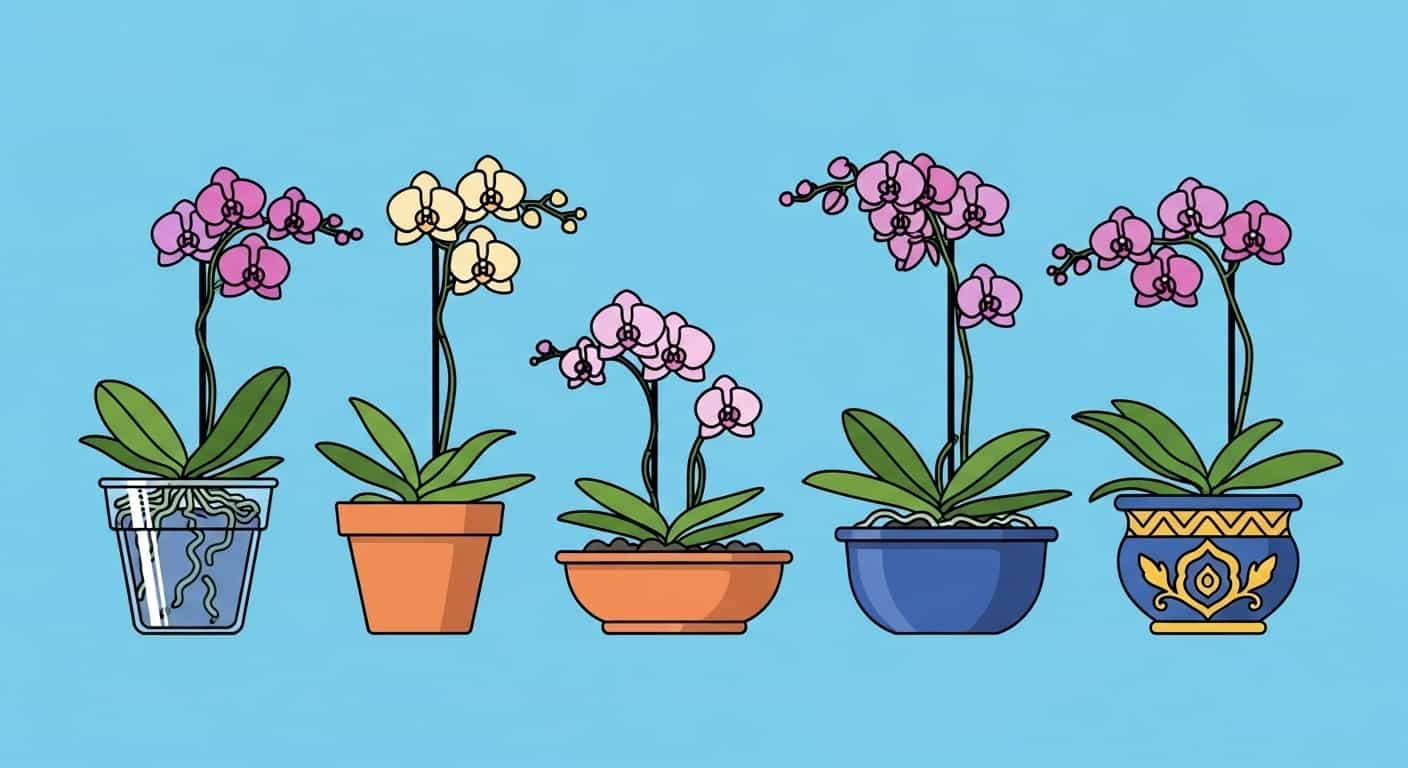Selecting the right pot is one of the most critical decisions you will make for the health of your orchid. While a beautiful decorative container can enhance a plant’s aesthetic appeal, the pot itself plays a vital functional role. For orchids, which have unique root systems adapted for life on trees, the wrong pot can quickly lead to disaster. The right container, however, provides the perfect balance of moisture, drainage, and airflow that these plants need to thrive.
This guide will walk you through everything you need to know about choosing the perfect home for your orchid. We will explore the pros and cons of different materials, answer the common question, “Do orchids prefer shallow or deep pots?”, and provide essential orchid potting tips to ensure your plant’s long-term success. Get ready to find the best pots for orchids and give your plant the foundation it needs to flourish.
Why Orchid Pots Are Different
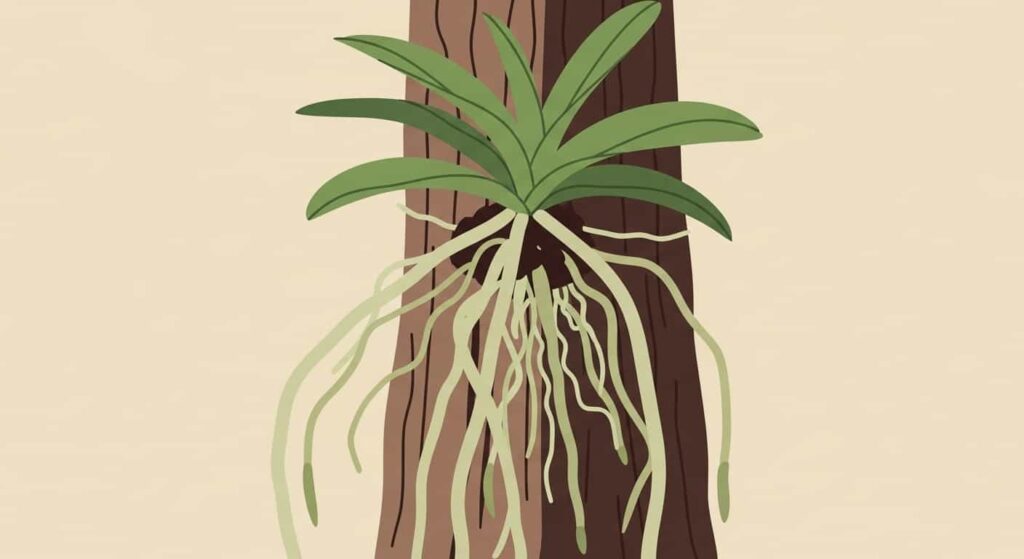
Before diving into pot selection, it’s essential to understand why orchids can’t be treated like typical houseplants. Most popular orchids, including Phalaenopsis, Cattleyas, and Dendrobiums, are epiphytes. In their native habitats, they grow on tree branches with their roots clinging to bark, completely exposed to the air. These roots are not designed to sit in dense, wet soil.
An orchid’s roots need three things to stay healthy:
- Air Circulation: Roots need to breathe. Constant airflow prevents them from suffocating.
- A Wet-Dry Cycle: They are built to absorb water quickly and then dry out relatively fast.
- Support: The pot’s primary job is to hold the plant upright while allowing the roots to do their thing.
A proper orchid pot is specifically designed to meet these three needs, which is why a standard terracotta pot for a succulent or a glazed ceramic pot for a fern won’t do.
Material Matters: Plastic vs. Clay
When you walk into a garden center, you’ll likely see two primary types of orchid pots: clear plastic and terracotta (clay). Each has distinct advantages and is suited for different growing styles and environments.
Clear Plastic Orchid Pots
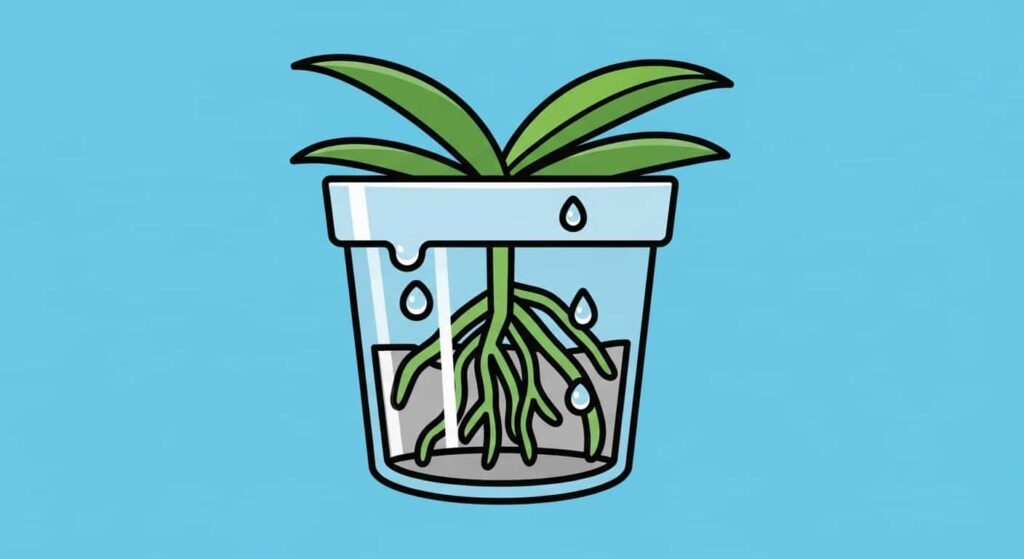
Clear plastic pots are overwhelmingly the best choice for beginners. Most orchids you buy from a store will come in one of these, and for good reason. They are inexpensive, lightweight, and offer several key benefits.
Pros:
- Root Visibility: The clear design allows you to see the orchid’s roots. This is the single most valuable tool for a beginner, as it lets you monitor root health and, most importantly, know exactly when to water. Healthy, hydrated roots are plump and green, while dry roots are silvery.
- Excellent Drainage: Plastic orchid pots are designed with an abundance of large drainage slots on the bottom and often on the sides, promoting superior airflow and preventing water from pooling.
- Moisture Retention: Plastic is non-porous, so it helps the potting mix dry out a bit more slowly than clay. This can be beneficial in dry homes or for orchids that prefer a little more moisture.
Cons:
- Less Stability: Being lightweight, they can sometimes be tipped over by top-heavy plants. This can be easily solved by placing the plastic pot inside a heavier decorative cachepot.
Terracotta (Clay) Orchid Pots
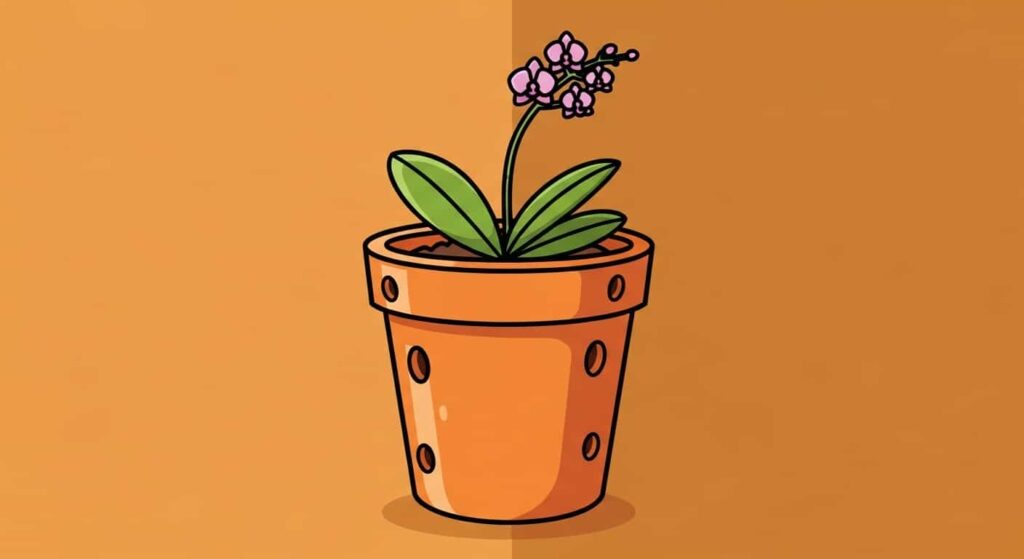
Terracotta pots are a classic choice and have been used by orchid growers for decades. They are particularly useful for certain types of orchids and for growers in very humid climates.
Pros:
- Superior Airflow: Clay is porous, meaning it breathes. This allows for excellent air exchange and helps the potting medium dry out very quickly, which is great for preventing root rot.
- Stability: Terracotta pots are heavy, providing a sturdy base for tall or top-heavy orchids like Cattleyas and Dendrobiums.
- Evaporative Cooling: As water evaporates from the clay walls, it provides a slight cooling effect to the root zone, which many orchids appreciate.
Cons:
- Dries Out Fast: The porosity that promotes airflow also means the potting mix dries out much faster. In a dry home environment, you may need to water much more frequently.
- Roots Can Cling: Orchid roots tend to stick firmly to the porous clay surface. This can make repotting difficult, often leading to root damage when you try to remove the plant.
- No Root Visibility: You cannot see the roots, so you have to rely on other methods (like pot weight or a skewer test) to determine when to water.
Pot Size: Why Snug is Better
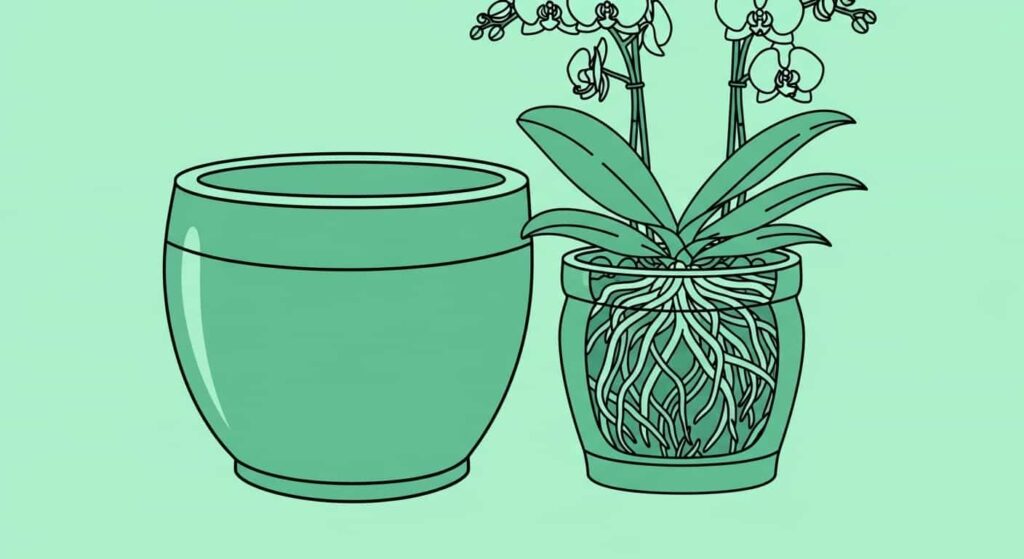
One of the most common orchid potting tips is to avoid over-potting. Unlike houseplants that appreciate lots of room to grow, orchids bloom best when they are slightly pot-bound or “snug” in their container.
When repotting, you should only select a new pot that is one to two inches larger in diameter than the previous one. Choosing a pot that is too large is a critical mistake because the excess potting medium will retain too much moisture for too long. The orchid’s limited root system can’t absorb all that water, leaving the mix to become a cold, swampy environment that inevitably leads to root rot.
The Great Debate: Do Orchids Prefer Shallow or Deep Pots?
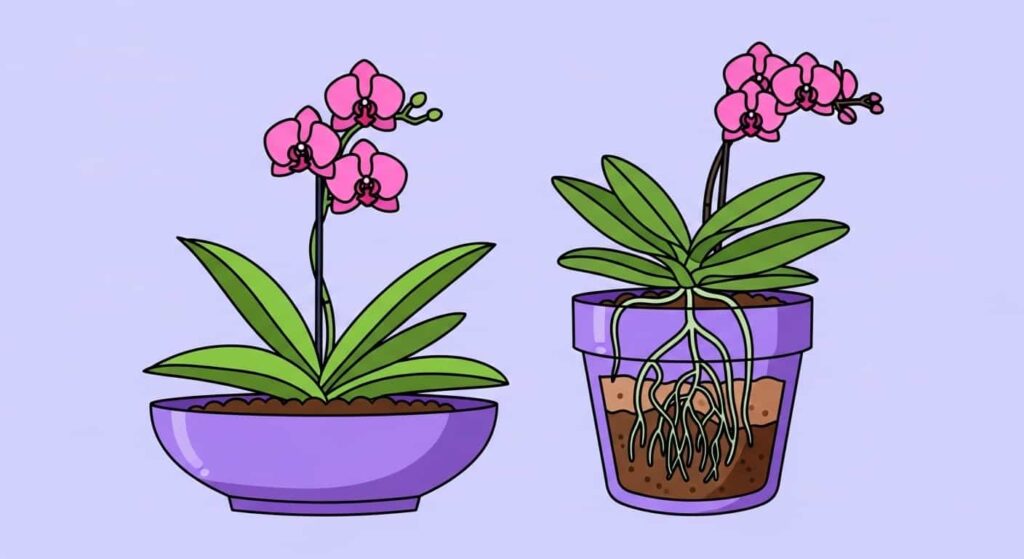
The answer to this question depends entirely on the type of orchid you are growing. Different orchids have different root growth habits.
Shallow Pots for Sprawling Orchids
Some orchids are “ramblers” with a sympodial growth habit, meaning they grow horizontally along a rhizome. This group includes many Cattleyas, Bulbophyllums, and some Dendrobiums. For these plants, a shallow, wide pot (often called a “bulb pan”) is more suitable than a deep one. It accommodates their sideways growth pattern without having a large volume of unused, damp potting mix at the bottom.
Deep Pots for Pendent Roots
Most beginner-friendly orchids, especially Phalaenopsis, have roots that prefer to grow downwards. For these plants, a standard-depth orchid pot is ideal. The depth gives the roots space to descend and anchor themselves. The key is to ensure the pot is not excessively deep relative to its width, as this can still lead to moisture problems at the very bottom.
For most beginners starting with a Phalaenopsis orchid, a standard clear plastic pot that is roughly as deep as it is wide is a perfect choice.
The Role of the Decorative Cachepot
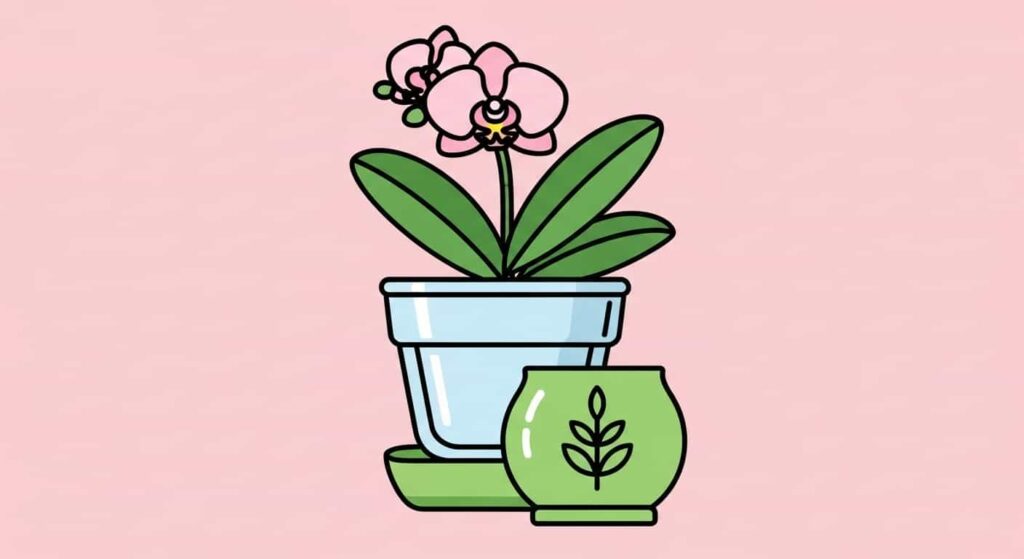
You don’t have to sacrifice beauty for function. The best practice for orchid growing is to use a properly sized, functional pot (like a clear plastic one) and then place it inside a more attractive decorative outer pot, or “cachepot.”
This two-pot system gives you the best of both worlds:
- The inner plastic pot provides the visibility and drainage your orchid needs.
- The outer cachepot provides stability and matches your home decor.
The most important rule when using a cachepot is to never let the inner pot stand in water. After watering, allow the inner pot to drain completely before placing it back inside the decorative container.
Putting It All Together: Your Potting Checklist
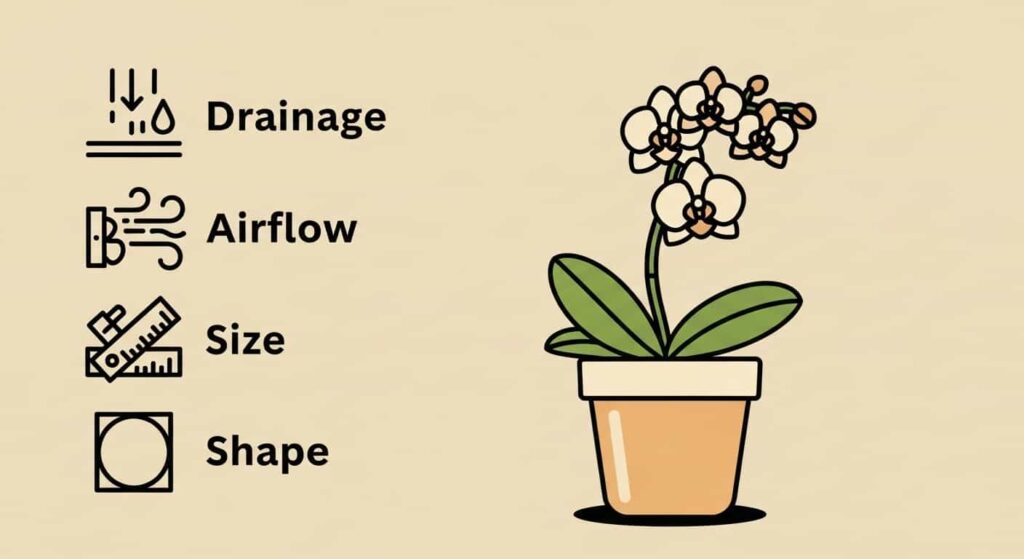
When it’s time to choose a pot for your orchid, run through this simple checklist:
- Is it an orchid pot? Look for a pot with lots of drainage holes on the bottom and, ideally, sides.
- What material is best for me? For beginners, clear plastic is highly recommended. Experienced growers or those in humid climates might prefer terracotta.
- Is it the right size? The pot should be just large enough to accommodate the roots with about an inch of space for new growth. Snug is good.
- Is it the right shape? For most Phalaenopsis, a standard pot is fine. For horizontally growing orchids, consider a wider, shallower pot.
Choosing the right pot is a foundational step in successful orchid care. By prioritizing drainage, airflow, and the appropriate size, you create a healthy environment where your orchid’s roots can thrive. This sets the stage for a strong plant that will reward you with beautiful blooms for years to come.
